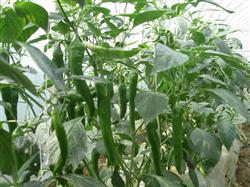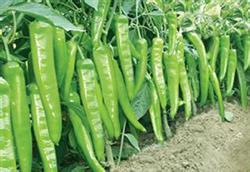Cultivation and management of pepper in greenhouse in spring

Since last winter, the market situation of slightly spicy pepper cultivated in greenhouse has been good all the way, so this newspaper specially introduces its planting techniques as follows: first, the flower buds of the middle and lower parts of seedling pepper have been differentiated in the seedling stage, so it is very important to cultivate sturdy seedlings for the quality of flower bud differentiation and early flowering and fruiting. In the suitable temperature in the seedling stage, the seedling age is generally about 35 days, and it is planted when the bud is not in bloom. Usually 9-13 true leaves. The seedling age is too short to blossom and set fruit. Second, soil preparation, fertilization and planting ⑴ pepper prefer potash fertilizer and phosphate fertilizer. Phosphate fertilizer should be fully applied in combination with organic fertilizer retting and ripening, and more potash fertilizer should be applied. Under normal circumstances, 50 kg of heavy superphosphate (46% phosphorus) is used per mu. The application of too much nitrogen fertilizer makes the leaves and branches tender and easy to grow, which is disadvantageous to flowering, fruit setting and later growth, the fruit becomes green and the fruit expands slowly. The ⑵ winter greenhouse should be planted around the end of September. Before and after ⑶ planting, the soil and planting holes were disinfected to prevent root rot and stem rot in time. Third, the management of ⑴ pepper is not resistant to drought or waterlogging. The variety has developed roots and vigorous growth. Before flowering and fruit setting, do not flood or water too frequently. Control the growth trend to prevent overgrowth and retting roots. ⑵ pepper adapted to the growth temperature between 15.5-35 ℃, the temperature is too high or too low, will affect the normal flowering and fruiting. The suitable temperature in the shed should be controlled at 18-28 ℃. ⑶ timely harvest door pepper, pepper to ensure that the middle and upper part of the normal flowering and fruit setting. The middle and upper part of ⑷ has strong continuous fruit setting ability, large fruit and high yield. Fertilizer and water management should be strengthened after fruit setting. High nitrogen, high potassium, high calcium and fertilizers containing medium and trace elements were applied in time to ensure the yield and commercialization of fruits in the middle and later stage. (large amount of fruiting period, nitrogen: phosphorus: potassium = 18:5:22 and trace element fertilizers containing calcium, magnesium, zinc, iron and other trace elements, topdressing 30-50 kg per mu (saleable area). Pepper harvest should not be empty, in case the upper part of the vigorous growth does not bear fruit. ⑸ pepper should be sprayed with fungicide before and after harvest to prevent stem rot caused by germs invading from the wound. 4. It is suggested that ⑴ root rot and stem rot (root rot) are important diseases of pepper. When planting hot pepper, special preparations should be applied at acupoints to control and prevent them as soon as possible. ⑵ this variety is sprayed with chemical growth control agents such as B9, dwarf, zhuangsu, paclobutrazol, uniconazole and other chemical growth control agents. if you do not master the time and temperature, the fruit will become shorter, bend and darker, affecting the yield and quality, so it should be used with caution.
- Prev

Management of Pepper after planting in greenhouse in Spring
Pepper in greenhouse in early spring is generally planted from mid-February to early March, and then poured enough bottom water, water seepage is divided into several times, sealing holes, and the planting mouth of plastic film is sealed. At this time, we should pay attention to the following three management work: after timely temperature control, ventilation and planting, the temperature outside the shed is still low, pay attention to heat preservation, and keep the temperature at 22-30 ℃ during the day.
- Next

Spring stubble chili peppers are straight and straight and do well at four points.
"the bending of chili fruit has a great influence on the price. Therefore, how to make chili peppers without bending fruit has become an important content for vegetable farmers to improve their income. Through the management of chili peppers over the past few years, I think that as long as we grasp the four points, chili peppers generally will not produce curved fruit. " Master Gong told the reporter. So, which four points did Master Gong say? First.
Related
- Where is it suitable to grow horseradish in China? it is expected to see the middle altitude horseradish in Alishan.
- How to prevent tomato virus disease reasonably? (Control methods included)
- Many people like to plant towel gourd on the balcony. What are the main points of this method and management?
- What crops can chili peppers be mixed with?
- Fertilization techniques and matters needing attention in Tomato
- What are the grafting techniques for peach seedlings in spring?
- Harm and control methods of root swelling disease of Chinese cabbage
- What are the pests of sweet potatoes? How to prevent and cure it?
- Symptoms, causes and Control methods of navel Rot in Tomato
- The cause of "Cucumber rotten bibcock" in Farmers' planting Cucumber and its Control Plan

